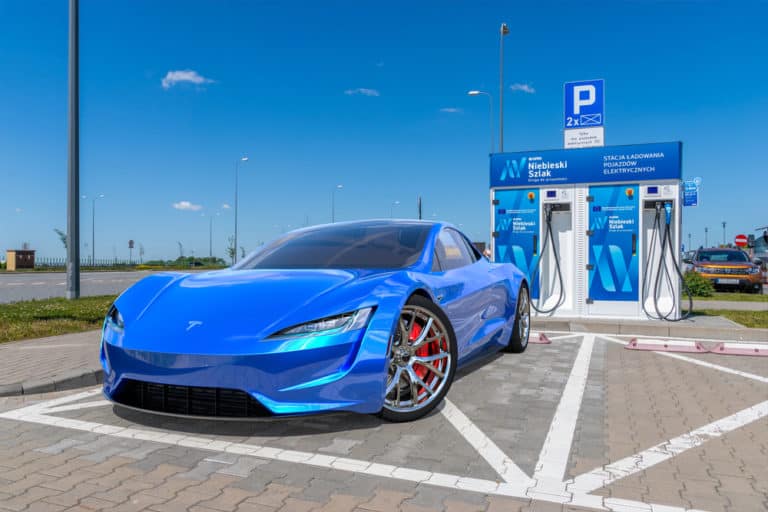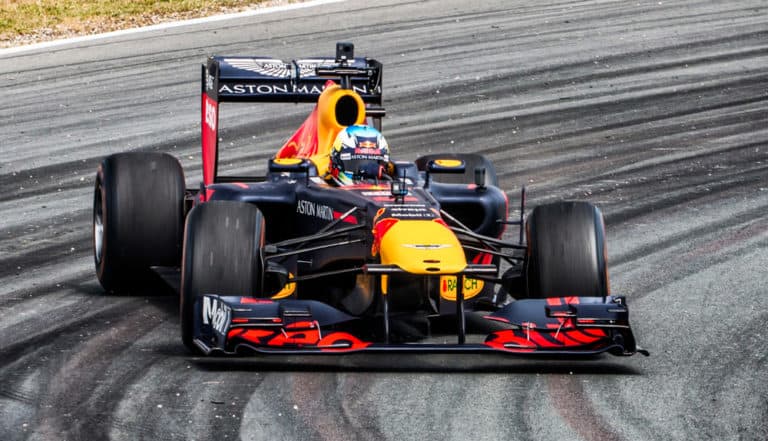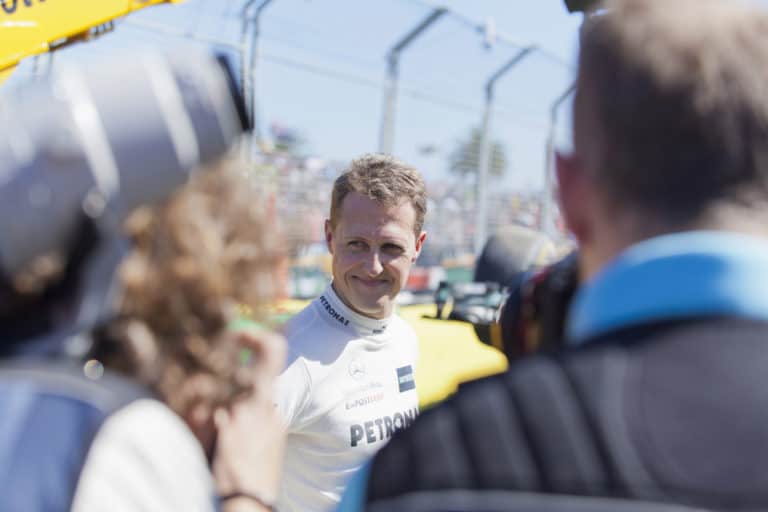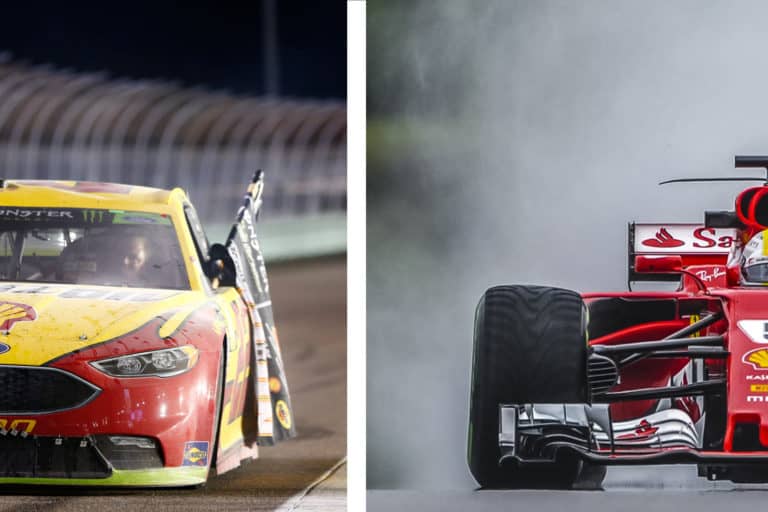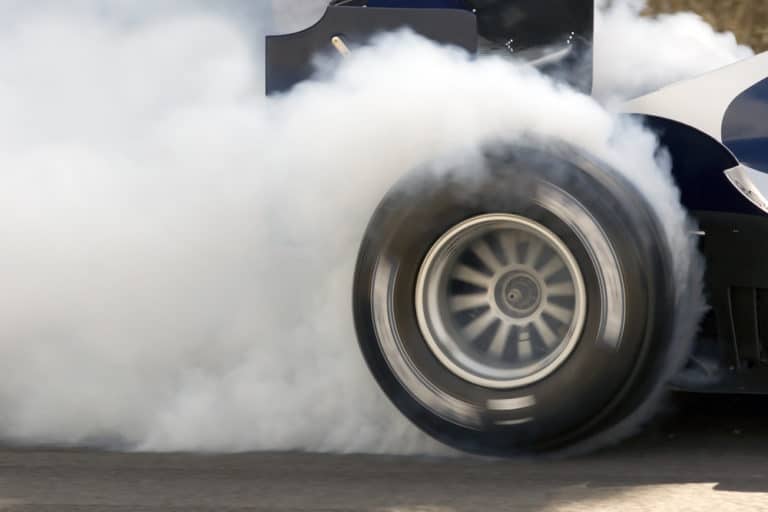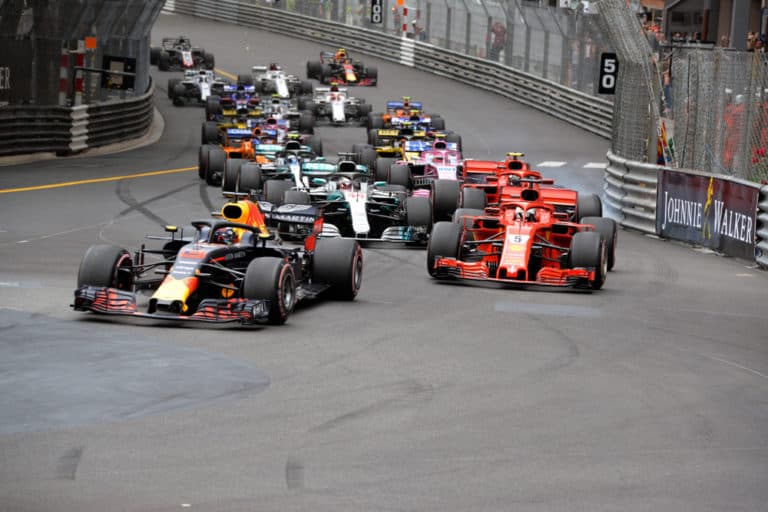Formula 1 is a constantly changing sport, including the teams as well. F1 teams don’t stay forever but rather come and go or rebrand themselves into another brand, so throughout history, there have been numerous F1 teams that no longer race or do so under another name.
Money is significant in F1, and the main reason most teams leave F1 is purely financial. Some defunct teams have made their mark on the sport, while others have passed quietly and simply survived race after race.
Let’s explore the graveyard of F1 teams to see which ones have disappeared in the last two decades.
If you’re looking for some F1 merchandise, check out the awesome stuff at the official F1 store here.
1. Benetton (1986-2001)
The prestigious clothing brand Benetton team was built from what was left of the Toleman team and was under the direction of flamboyant businessman Flavio Briatore until 1997.
Benetton started as a midfield team but soon became quite competitive, achieving success in the mid-1990s, reaching its peak with Michael Schumacher. They won the 1994 and 1995 drivers’ championships and the constructors’ in 1995.
The team achieved 102 podium finishes, 27 wins (19 by Schumacher), 15 pole positions, and 36 fastest laps. It had several engine suppliers such as BMW, Ford-Cosworth, or Playlife, but it was with Renault that they won the world titles.
After the departure to Ferrari of some key men such as Schumacher, Ross Brawn, and Nigel Stepney, the team declined, and in 2001 it was sold to Renault.
2. Prost (1997-2001)
Four-time world champion Alain Prost founded his own team after buying the French Ligier team in 1997, which he had wanted to do since 1992.
The team kept the dark blue of Ligier and the sponsorship of the Gauloises tobacco company. After a promising 1997, in which they achieved two podiums with Olivier Panis, a third place in the Brazilian GP and a second in the GP of Spain, 1998 was an absolute failure. They only got one point with Jarno Trulli.
In 1999 they improved a bit, getting a second place in the European GP with Trulli, and from 2000 the team began its decline, being last in the championship.
Following the departure of its main sponsor, Gauloises, at the end of 2000, the team was unable to recover and went bankrupt in early 2002. Reflecting on the experience, Alain Prost stated that Prost Grand Prix was his biggest mistake.
3. Arrows (1978-2002)
Arrows Grand Prix International was a British F1 team founded by Italian businessman Franco Ambrosio, Alan Rees, former racing driver Jackie Oliver, Dave Wass, and Tony Southgate. The team’s name is derived from the initials of their surnames. Between 1991 and 1996, they were known as Footwork Arrows.
They are considered one of the best teams never to win a race. They were a midfield team fighting for podium finishes, with 1987, 1988, and 1989 being their best years, finishing 7th, 5th, and 7th in the constructors’ championship, respectively.
Arrows scored nine podiums and one pole position during their existence. They came close to winning the 1997 Hungarian GP with defending champion Damon Hill but lost out to Jacques Villeneuve.
Ricardo Patrese took the team’s only pole position at the 1981 United States GP at Long Beach and was Arrows’ most successful driver, obtaining 4 of their 9 podium finishes. Arrows set the unenviable record of 382 races without a win in their checkered history.
4. Jaguar (2000-2004)
The iconic Jaguar brand entered Formula 1 from the purchase by Ford of Jackie Stewart’s Stewart Grand Prix F1 team in 1999.
Although the expected performance was never met, there were high hopes for the team, as the team was unable for the majority of the seasons to challenge for points consistently.
Despite the team’s rebranding, they continued to use full-works Ford Cosworth engines, and no Jaguar engineering was involved, so all that was Jaguar was its sleek dark green livery. In their five seasons, they finished in the constructors’ championship ninth, eighth and seventh three times in a row.
Eddie Irvine claimed the team’s only two podium finishes at the 2001 Monaco GP and the 2002 Italian GP, finishing third. Other noted drivers of the team were Pedro de la Rosa, Mark Webber, Justin Wilson, and Christian Klien.
The team was bought at the end of 2004 by the energy drink giant Red Bull, as it did not bring much revenue to Ford despite a large amount of money invested.
5. Minardi (1985-2005)
Minardi was an Italian team founded by Giancarlo Minardi and raced in F1 from 1985 to 2005. It was never very successful and never had competitive cars.
During their existence, they scored a total of 38 championship points; 16 of these achieved by the team’s first driver, Pierluigi Martini, who also recorded the team’s only front-row start at the 1990 United States GP and led the only lap Minardi ever led, during the 1989 Portuguese GP.
Despite the team’s poor performance, Minardi was a well-liked team for its friendliness, accessibility, and lack of corporate culture. Their cars were considered by many to be very well designed despite their small budget and lack of funds.
They also resisted employing pay drivers more than most other financially strapped teams. Drivers who have driven for Minardi include Fernando Alonso, Giancarlo Fisichella, Jarno Trulli, and Mark Webber, among others.
In 2005 it was bought by Red Bull and became Scuderia Toro Rosso.
6. Jordan (1991-2005)
Jordan Grand Prix raced from 1991 to 2005 and was founded by Irish businessman Eddie Jordan.
Although they had very competitive and fast cars, it was a midfield team, especially from 1994 to 2001, with 1997 being their best season. They finished 3rd in the constructors’ championship with Damon Hill and Heinz-Harald Frentzen.
It was a team beloved by Eddie Jordan’s easy-going, friendly demeanor, and from 1997 their cars became very recognizable for being yellow and black, thanks to the sponsorship of the tobacco company Benson & Hedges.
Jordan achieved 4 wins, 19 podiums, 2 pole positions, and 2 fastest laps throughout its existence. Heinz-Harald Frentzen was their most successful driver, taking 2 wins and 8 podium finishes in 3 seasons, while Damon Hill and Giancarlo Fisichella each took a win.
The team was sold to the Midland Group, who renamed it Midland in 2006, it was subsequently sold to Spyker in 2007, and in 2008 it was sold again, becoming Force India.
7. BAR (1999-2005)
British American Racing (BAR) acquired Tyrrell and was owned by British American Tobacco (BAT), which sponsored the cars with its Lucky Strike and 555 brands.
The team used Supertec engines in its first season and then switched to Honda, with whom they would form an alliance for the rest of the seasons.
The team’s first season was terrible, but with the arrival of Honda, they improved significantly and consolidated as a strong midfield team. Their best season was 2004, in which they finished 2nd in the constructors’ championship, with Jenson Button finishing 3rd and scoring 10 podiums, while Takuma Sato 1.
In their 7 seasons, they achieved 15 podiums and 2 pole positions, with Jenson Button being the most successful driver and a vital part of the team. Other team drivers included Jacques Villeneuve, Olivier Panis, and Ricardo Zonta, among others.
At the end of 2005, Honda obtained 100% ownership of BAR, becoming a full F1 manufacturer team.
8. Midland (2006)
Canadian businessman and owner of the Midland Group, Alex Shnaider, purchased Jordan in late 2004 but still raced as Jordan through the 2005 season.
2006 was the team’s only season as a Midland, and they ran in a red, white, and black livery, the corporate colors of the Midland Group, and were powered by Toyota. They had Tiago Monteiro and Christijan Albers as drivers.
The car was not very competitive during the season, and their drivers only ran ahead of Super Aguri on race. However, they did improve the car during the season, but insufficient.
The team was disqualified from the German GP for running a flexible wing in contravention of the sport’s technical regulations. They did not get any points in the season and finished 10th in the constructors’ championship.
In September 2006, the team was sold to Spyker Cars, and the team raced in its last three GPs under the official name “Spyker MF1 Racing” before becoming Spyker F1 in 2007.
9. Spyker (2007)
After the Dutch manufacturer of hand-built cars, Spyker Cars, purchased Midland, the cars switched their livery to an orange and silver scheme, with orange being the national color of the Netherlands. The team used customer 2006-spec Ferrari engines and started the season with Adrian Sutil and Christijan Albers as their official drivers.
Like the previous year, the team was not very competitive, and their cars were always at the bottom of the grid. After the British GP, Albers went out on loan due to a lack of sponsorship money. German Markus Winkelhock replaced him for the European GP.
Winkelhock only ran that race and started last, but thanks to starting on full wet tires while the rest of the field was on dry-weather tires, he was able to lead the race for a few laps until it was suspended. He was overtaken by faster cars on the restart and finally retired on lap 15.
Winkelhock is the only driver in F1 history to start last on the grid and lead the race in his first GP, and also is the only driver in F1 history to begin first and last on the grid on the same GP.
However, he was replaced by Sakon Yamamoto for the rest of the season. Spyker only managed one point with Sutil at the Japanese GP and was sold to Indian businessman Vijay Mallya at the end of the season.
10. Honda (2006-2008)
Honda continued with the BAR project, but for a short time, because in 2008, they announced their withdrawal from F1 due to the global economic crisis. Honda drivers during those three seasons were Jenson Button and former Ferrari driver Rubens Barrichello.
During the 2006 season, Honda had a competitive, if unreliable, car, with the team dropping out of contention for race victories many times. They finished 5th in the constructors’ championship, and Button took a pole and third place at the Malaysian GP, a victory at the Hungarian GP, and a third-place at the Brazilian GP.
However, in 2007 and 2008, they had a big slump and could barely fight for points. Their biggest headline was the “Earth Car” livery, depicting planet Earth against a black space background and the podium Barrichello took at the 2008 British GP.
11. Super Aguri (2006-2008)
Former Japanese F1 driver Aguri Suzuki founded super Aguri. It was based in Tokyo but operated from the former Arrows factory in Oxfordshire, England.
The team was powered by customer Honda engines and functioned to some extent as an unofficial Honda “B” team. Takuma Sato drove for Super Aguri for all three seasons, and his teammates were Yuji Ide, Franck Montagny, and Sakon Yamamoto in 2006 and Anthony Davidson in 2007 and 2008.
For the 2006 season, the team used an updated version of the 2002 Arrows and using such an old version had adverse effects as they were the slowest team on the grid.
Super Aguri was the slowest team during the 3 seasons, although in 2007 Takuma Sato was able to get 4 points, which allowed the team to finish 9th in the constructors’ championship. In 2008, the team withdrew from F1 due to financial difficulties.
12. Toyota (2002-2009)
Toyota entered Formula 1 for the 2002 season. With one of the largest budgets in the sport and being the largest car manufacturer in the world, hopes were very high, although their expectations were never met, as, in 8 seasons, they did not get a single victory.
The team’s first three seasons were very uncompetitive. They barely fought for points, but 2005 saw an improvement, finishing 5th in the constructors’ championship, with Jarno Trulli scoring 3 podiums and Ralf Schumacher 2.
However, they were never able to overcome this season, and in 2006 and 2007, they finished 6th in the championship and 2008 and 2009 5th, scoring occasional podium finishes by Jarno Trulli and Timo Glock.
Due to the economic crisis at the end of 2009, like many other teams, Toyota withdrew from F1 through the back door.
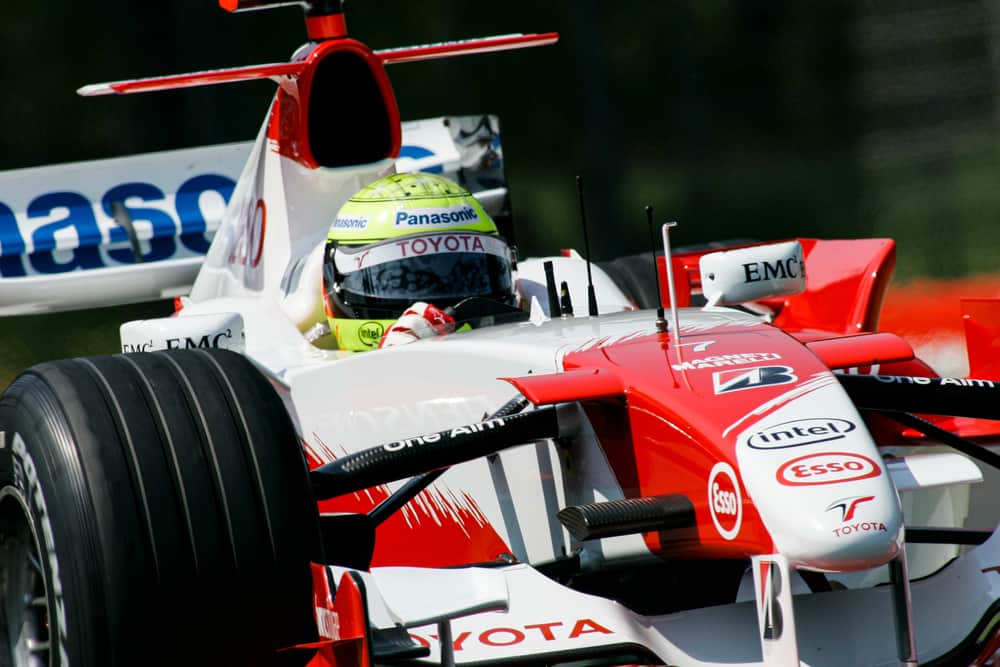
13. Brawn GP (2009)
Brawn GP, in statistical terms, is the most successful team in the history of F1, with a 100% success rate, since it only raced in one season, 2009, winning both the drivers’ and the constructors’ titles.
The then Honda team principal, Ross Brown, took over the team, renaming it to Brawn GP and buying it for a nominal price in the absence of buyers. Honda drivers Jenson Button and Rubens Barrichello remained with the team.
For the 2009 season, there were not many hopes for the team due to its moderate budget and lack of investors. 2009 was a year of regulation changes, as the cars’ aerodynamics were considerably simplified. The team used Mercedes engines and appeared in the first race with a practically empty car without sponsors.
However, the car’s performance surprised everyone. Jenson Button took 6 wins and 3 podium finishes during the season and won the drivers’ championship. Rubens Barrichello took 2 wins and 4 podium finishes, being third in the championship at the end of the season.
Many new sponsors were brought in throughout the season, and in the last race, the car was no longer as empty as it was at the beginning.
The key to the team’s success was the innovation of the double diffuser, which provided additional downforce to the car without increasing drag levels, which meant a clear advance at all levels. At the end of 2009, Mercedes bought the team and returned to F1 as a manufacturer.
14. BMW Sauber (2006-2009)
German luxury car and motorcycle manufacturer BMW bought the Swiss Sauber team in 2005 and retained the Sauber name for historical reasons. Interestingly, in 2006 and 2009, the team obtained 2 podium finishes and 36 points in the constructors’ championship, finishing 5th and 6th, respectively.
However, their best seasons were 2007 and 2008. In 2007, Nick Heidfeld took 2 podium finishes, and thanks to McLaren’s disqualification from the season, they placed 2nd in the constructors’ championship.
Their strongest season was undoubtedly 2008. Heidfeld took 4 podiums and Robert Kubica 5 podiums and the team’s only win during their existence at the 2008 Canadian GP and BMW’s only pole position at the Bahrain GP.
At the end of 2009, BMW withdrew from F1 and sold the team back to founder Peter Sauber.
15. HRT (2010-2012)
In 2010, 3 new teams entered Formula 1: Hispania Racing Team (HRT), Lotus Racing, and Virgin. HRT was the first Spanish team to race in F1 and was founded by former driver Adrián Campos and sold to businessman José Ramón Carabante before its debut in 2010 and then to an investment group in 2011.
From the beginning, HRT was characterized by having a very limited budget and was always looking for potential investors and financing.
Because of this, during its three seasons, the team was one of the slowest on the grid alongside Virgin and Lotus Racing and was merely surviving. They couldn’t even use the KERS system in their cars.
At the end of 2012, the team disbanded due to a lack of buyers. Some drivers who raced for HRT were Bruno Senna, Narain Karthikeyan, Daniel Ricciardo, and Pedro de la Rosa.
16. Lotus Racing / Team Lotus / Caterham (2010-2014)
The history of this team is similar to that of HRT since they always had financing problems and had one of the slowest cars on the grid, unable to score points in the races, although they were able to survive 2 more seasons.
Lotus Racing was created with support from the Malaysian government and a group of companies such as Air Asia. The team had a dispute with Lotus Cars, as the name was misleading, although, in reality, it had nothing to do with Colin Chapman’s historic team.
In 2012, Team Lotus, as it was named in 2011, was bought by businessmen Tony Fernandes and acquired by British sportscar manufacturer Caterham Cars, forming the Caterham F1 Team.
Despite the new buyers, neither the financing nor the results improved, and by 2014, the team did not participate in some races due to lack of money and crowdfunded to compete in the last race. At the end of the year, the team was auctioned and dissolved.
17. Lotus F1 Team (2012-2015)
Lotus F1 Team was a British team built on the Lotus Renault team after it was bought by the Luxembourg company Genii Capital at the end of 2011. It was named after its branding partner Group Lotus, recovering the classic gold and black colors.
2012 and 2013 were their best seasons, with 2007 world champion Kimi Raikkonen and Romain Grosjean coming fourth in the constructors’ championship. In 2012, Raikkonen got 1 win and 6 podium finishes, while Grosjean got 3 podium finishes. In 2013, the Finn was able to get 1 win again, and 7 podium finishes, while the French got 6 podium finishes.
However, following Raikkonen’s departure and the 2014 regulation changes, the team became very uncompetitive. It went on to fight for points, although Grosjean scored a podium finish in 2015 at the Belgian GP. In addition, they also began to have financing problems from 2013.
At the end of 2015, the team was sold back to Renault.
18. Virgin / Marussia / Manor (2010-2016)
The history of Marussia is also similar to that of HRT and Caterham, although with more pain and some glory.
In 2010 and 2011, the team was Virgin Racing, promoting Richard Brandson’s empire. In 2012, Russian manufacturer Marussia took over the team until 2015, when it was rescued by OVO Energy boss Stephane Fitzpatrick and changed the name to Manor.
Like HRT and Caterham, the team was always looking for buyers and on a shoestring budget, with their cars always at the back of the grid. They did not participate in the last three races of 2014 due to a lack of financing.
As Marussia, they took a ninth position at the 2014 Monaco GP at the hands of promising youngster Jules Bianchi, who sadly passed away in 2015 following an accident at the 2014 Japanese GP. Marussia also lost another driver, test driver Maria de Villota, in 2013 due to an accident during a test in 2012.
As Manor, Pascal Wehrlein scored a point in Austria in 2016. Eventually, the team disbanded due to financial problems.
19. Force India (2008-2018)
Force India raced in F1 from 2008 to 2018 after Indian businessman Vijay Mallya and Dutch businessman Michiel Mol bought the Spyker F1 team.
The team started poorly but gradually established itself as a strong midfield team, finishing fourth in the constructors’ championships in 2016 and 2017. During 2008 they did not get any points, but in 2009 they got their first points at the Belgian GP with Giancarlo Fisichella, who took pole and came second in the race.
From there, Force India started scoring consistently between 2010 and 2013, and with the change of regulations in 2014, they switched from Ferrari to Mercedes engines, and the team’s performance improved further.
Sergio Pérez obtained 5 podiums for the team between 2014 and 2018, being Force India one of the great midfield teams.
In 2018, Vijay Mallya, accused of fraud and defaulting on loans, could not afford to run the team any longer, and a consortium of investors called Racing Point UK, led by Lawrence Stroll, bought the team and renamed it Racing Point. It is currently the Aston Martin team.

